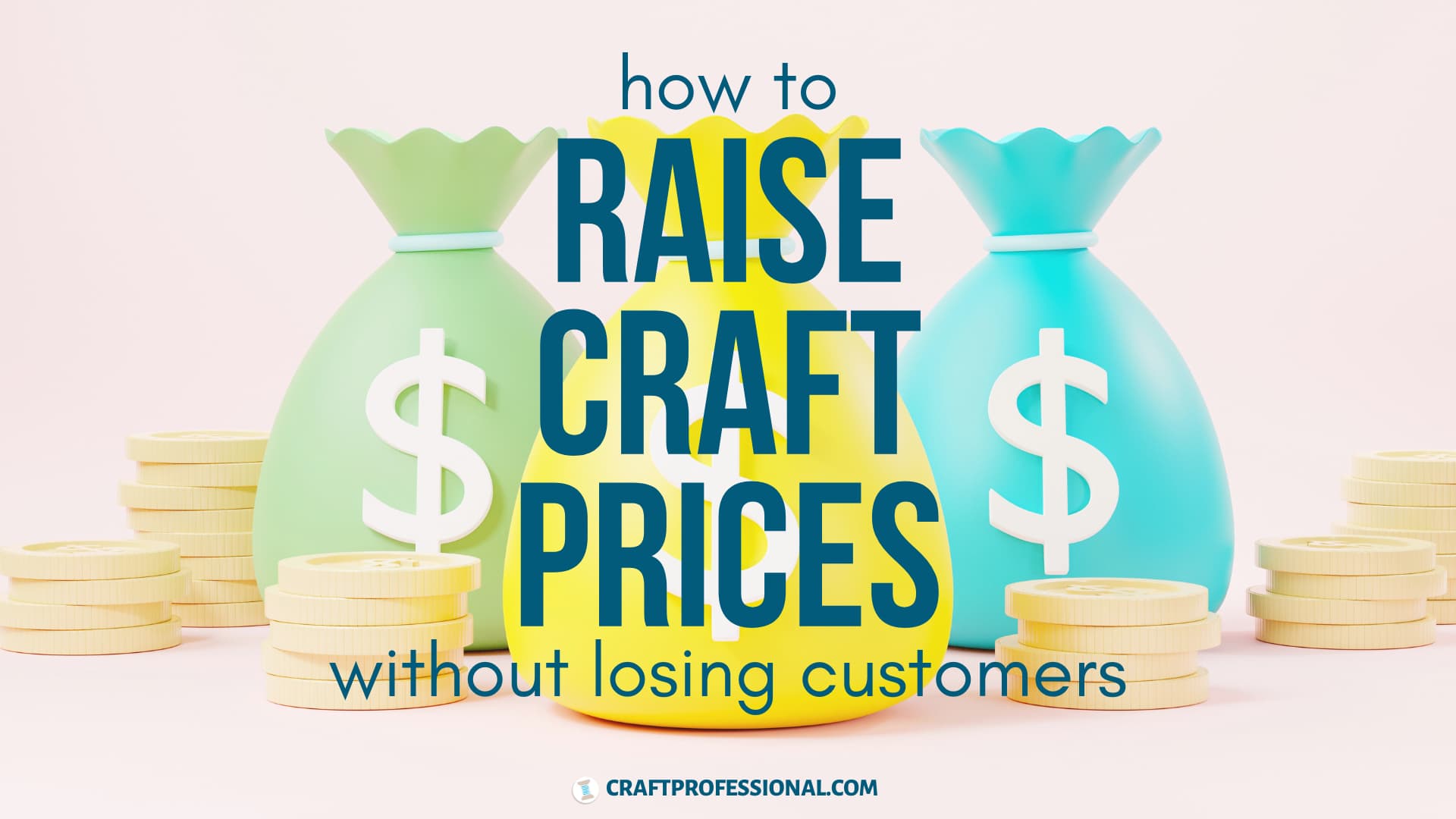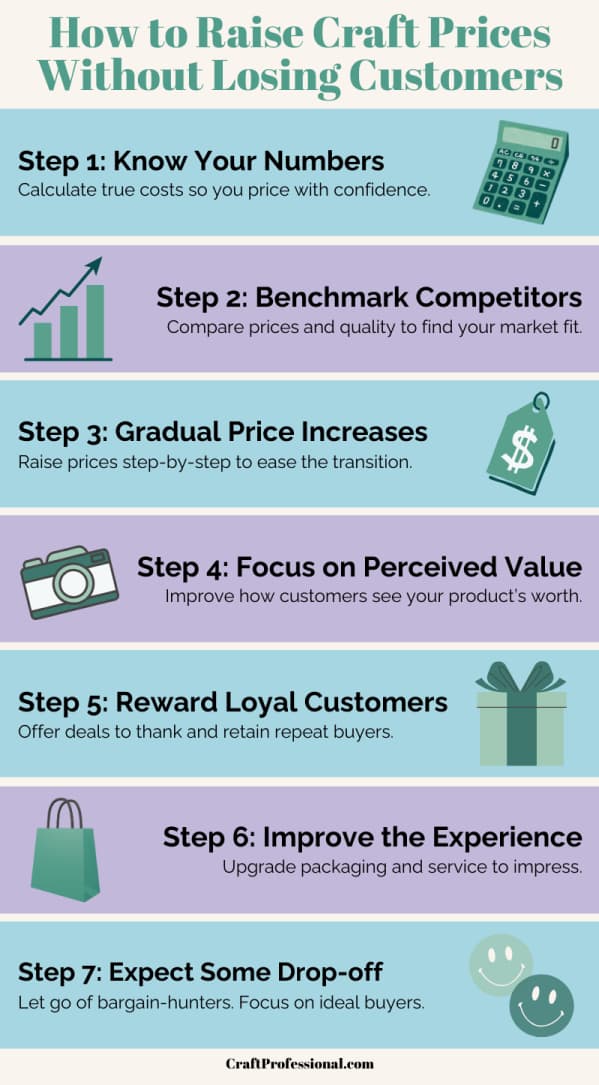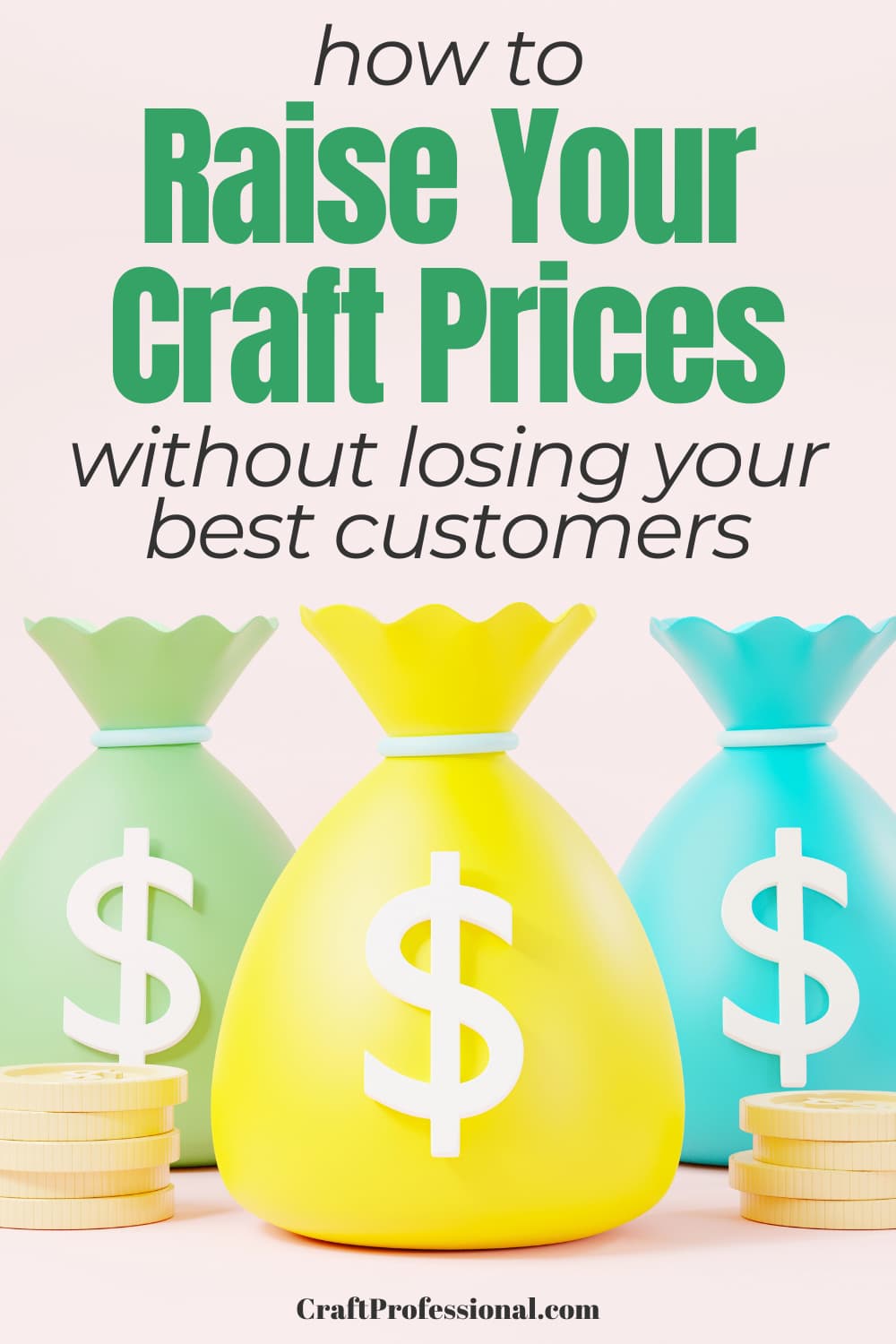- Home
- Craft Pricing
- How to Raise Craft Prices
How to Raise Craft Prices Without Losing Loyal Customers
Need to raise craft prices to keep your business profitable, but you're worried that will scare off buyers?
You're not alone.
Pricing handmade products can be a big challenge, especially when it's time to raise prices.
This guide shows you exactly how to raise your craft prices confidently and without losing your loyal customers.

How to Raise Craft Prices
Table of Contents

Why You Might Need to Raise Prices
You might hesitate to increase your prices, but here's the truth: your time, skill, and creativity deserve fair compensation.
Common reasons to raise craft prices include:
- Rising costs of materials or shipping
- Undervaluing your time and expertise
- Comparing your pricing to similar, higher-priced competitors
- Growing demand or limited capacity to keep up
Reality Check: If your crafts are selling fast, or if you're underpaying yourself, a price increase is overdue.
What Customers Actually Care About (It's Not Just Price)
Customers don't only buy based on price. They buy based on perceived value.
What is perceived value?
It is the customer's belief about how much a product is worth. It's abount more than just the price or product. The overall shopping experience, quality, presentation, brand reputation, and emotional connection impact customers' impression of your product's worth.
It's what makes a buyer feel that a handmade item is worth the price, even if it costs more than a similar alternative.
Some factors that can boost your product's perceived value include:
- Quality craftsmanship
- Unique or custom designs
- Professional branding and packaging
- Positive customer reviews
- Your story (yes, it matters!)
Action Tip: Improve your product presentation with better product photos, clearer descriptions, or upgraded packaging. These low-cost changes can boost perceived value and justify your price.
How to Raise Prices Without Losing Customers
Here's a step-by-step process to increase your prices while keeping customers happy (and maybe even attracting better ones).
1. Know Your Numbers First
Before increasing prices, calculate your current costs including:
- Cost of materials
- Time spent per item (include prep and packaging)
- Overhead (website, craft fair fees, Etsy fees, etc.)
Check how much profit is built into your current prices as well.
If you're not sure how to get started calculating these numbers, read more about craft pricing formulas and find one that's a match (or a close match) to your own pricing strategy.
You can also use our free online craft price calculators to do some quick math and assess your own numbers.
2. Benchmark Against Competitors
Research similar handmade items:
- Are you priced lower than average?
- Are you offering more customization or better quality?
If you're underpriced, your pricing is not sustainable, and customers may even doubt your quality. Luckily, you'll be able to raise your prices without raising too many eyebrows. In this case, customers will expect higher prices.
If your prices are higher than the competition, you'll need to work hard on perceived value to show shoppers why your products are special and worth paying a premium price.
3. Consider Using a Gradual Price Increase Strategy
Instead of doubling prices overnight:
- Start with a 10–15% bump.
- Increase prices on bestsellers first.
- Keep older prices for limited stock (e.g., "while supplies last").
Communicate scarcity and urgency when phasing out older prices.
Example: "Due to rising material costs, prices on this collection will increase next month. Order now to lock in current rates!"
4. Explain the Value (Not the Cost)
That language you use matters. Your messaging should focus on what makes your product special, not on costs or inflation.
Try phrases like:
- Our pieces are handcrafted with premium materials.
- Each item is custom-made with care and precision.
- We've refined our techniques to make these even more durable and beautiful.
5. Reward Loyalty or Offer a Transition Deal
Let repeat buyers know they matter:
- Send a coupon code to your email list: As a thank-you, here's 10% off our new spring line.
- Offer bundles (buy 2, get 1 at old price) to ease the transition.
- Give returning customers exclusive access to new items.
These strategies allow you to offer a loyalty reward or slightly discounted price to ease repeat customers into the newer price without cheapening your brand.
6. Improve the Buying Experience
What makes your product feel worth more?
- Upgrade your packaging (tissue paper, tags, handwritten thank-yous)
- Upgrade your product photos to showcase quality and detail
- Add lifestyle photos and usage ideas
- Offer faster or more reliable shipping
Boosting your product's perceived value is essential if you're going to make the most of your craft business.
The book How to Price Crafts and Things You Make to Sell is hands-down the best resource I've read on the topic
If you want to know, in depth, how to raise craft prices without losing customers, this book is a must-read.
7. Prepare for (Some) Drop-Off (It's Okay)
Yes, you may lose a few price-sensitive shoppers if you raise your prices significantly. That's okay. Building your business around those customers' expectations will set you on a path to burnout.
Remember, your ideal customers are those who value your work and are willing to pay a fair price that allows you to build a sustainable business. Those shoppers will stay and even appreciate your confidence.
Final Thoughts: It's Time to Value Your Work
Raising your prices isn't greedy. It's responsible. It ensures you can keep doing what you love, grow your business, and serve your customers even better.
Ready to increase your prices and your confidence?
Let this be the moment you take your craft business to the next level!
Frequently Asked Questions: Raising Craft Prices
How can I increase rates on handmade items without losing customers?
How can I increase rates on handmade items without losing customers?
Start by clearly understanding your costs and value. Then, communicate benefits like premium materials, unique design, or craftsmanship. Use gradual increases, offer loyalty rewards, and focus on boosting perceived value with better branding and presentation.
What is perceived value, and why does it matter in craft pricing?
What is perceived value, and why does it matter in craft pricing?
Perceived value is how much a customer believes a product is worth. It is influenced by more than just price. Packaging, storytelling, customer experience, sales venue, and product uniqueness all shape that perception. Higher perceived value justifies higher prices.
Should I raise prices on all of my products at once?
Should I raise prices on all of my products at once?
Not necessarily. Consider starting by raising prices on bestsellers or limited collections. You can also introduce new products at higher price points and phase out lower-priced items gradually.
What do I say to customers when I raise my prices?
What do I say to customers when I raise my prices?
Frame the message around quality, care, and sustainability.
For example:
"To continue using high-quality materials and craftsmanship, we're updating our prices. Thank you for supporting handmade and small business!"
Avoid apologizing or over-explaining. Be confident and transparent.
Is it normal to lose some customers when raising prices?
Is it normal to lose some customers when raising prices?
Yes, some bargain-seekers may drop off. Focus on attracting customers who appreciate your work and are willing to pay a fair price. You can build a profitable, sistainable business around this type of customer.
How often should I reevaluate and adjust my prices?
How often should I reevaluate and adjust my prices?
Review your pricing at least twice a year or when material costs, demand, or time investment changes significantly. Staying proactive ensures your pricing supports a sustainable business.
Question
Answer



New! Comments
Have your say about what you just read! Leave me a comment in the box below.